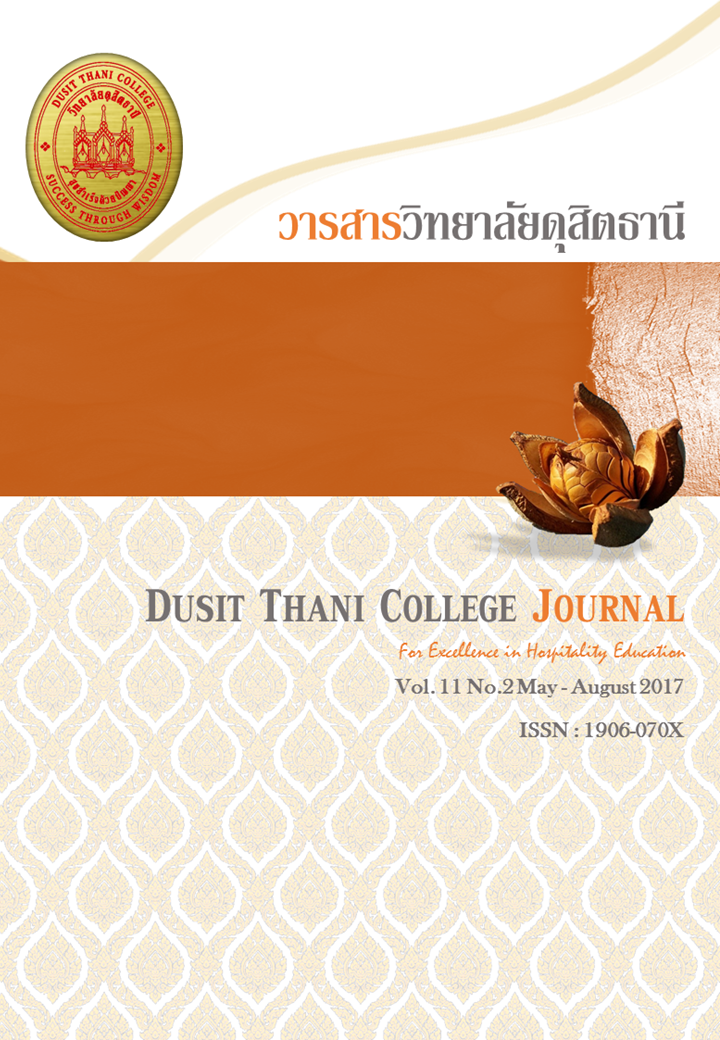Factors Affecting Employee Engagement of 3 Star Hotels Businesses in Bangkok
Main Article Content
Abstract
The purposes of this research were 1) to study the factors in employee engagement of front office department in 3-star hotel businesses in Bangkok; and 2) to study comparison of factors in employee engagement of front office department in 3-star hotel businesses in Bangkok, the samples were 157employees in front office department from 3-star hotel businesses in Bangkok. Questionnaire was used to collect data. Cronbach Alpha Coefficient reliability test is 0.946. Descriptive statistic were average ( ), standard deviation (S.D.), as well as the inferential statistic were t-test and one-way analysis of variance were used to analyse the data.
Research findings showed that 1) The majority of 3-star hotel worker in Bangkok was female (66.24%), aged between 26-30 (33.76%), single status (60.51%), undergraduate level (57.96%), obtain a degree in a different field of hotel management (52.87%), salary income over 25,000 (33.76%), operational staff (52.87%) and work duration between 1-2 years (31.21%) and 2) The individual factors including job position and work duration significantly influence employee engagement in a significance level of 0.05. Nevertheless, gender, age, status, educational background about hotel management, and salary income were not effect to employee engagement.
Article Details
Article Screening Policy
- All research and academic articles to be published must be considered and screened by three peer reviews in the relevant field / article.
- All articles, texts, illustrations and tables published in the journal are the personal opinions of the authors. Editors don't always have to agree. And no responsibility whatsoever is the sole responsibility of the author.
- The articles to be published must never be published. Where did you first publish? And not in the consideration of other journals If the audit found that there has been a duplicate publication It is the sole responsibility of the author.
- Any article that the reader sees as being plagiarized or impersonated without reference. Or mislead the work of the author Please let the journal editor know it will be your greatest blessing.
References
Buchanan, H. (1974). building organization commitment the socialization of managers in work organization. Administrative Science Quarterly, 19.
Burke. (2016, June 21). Employee Engagement. Retrieved from Burke.com: https://www.burke.com
Cherrington, D. (1994). Organizational Behavior: The Management of Individual and Organizational Performance. USA: Allyn and Bacaon.
Cohen, J. (1988). Statistical Power Analysis for the Behavioral Sciences. New Jersey: Lawrence Erlbaum Associates.
Crabtree, S. (2006). Getting Personal in the Workplace Are negative relationships squelching productivity in your company. The Gallup Management Journal.
Kanter, R. (1968). Commitment and Social organization : A study of commitment mechanisms in utopian communities. American social review, 499-517.
Kanter, R. (1968). Sociological Review. American.
Kantipong, P. (2014). Enagement for Quality. Bangkok: The faculty of Medicine Siriraj Hospital .
Marsh, R., & Mannari, H. (1977). Organization Commitment and yummier: A production study. Administrative Science Quarterly, 22.
Metekasiwat, K. (2012). The Relationship Between The Employees’ Work And Organisation Engagement And Their Intention To Quit The Hotel Job In Nakhon Ratchasima Province. Nakhonratchima: Suranaree University of Technology.
Ministry of Tourism and Sports. (2015). Tourism Economic Review. Bangkok: Office of the Permanent Secretary ,Ministry of Tourism and Sport.
National Statistical Office. (2014). The 2014 Hotel and Guest houses survey. Bangkok: Ministry of Informaiton and Communication Technology.
Pantapalangkul, P. (2012, July 11). Employee Engagement. Retrieved from prakal.wordpress.com: https://prakal.wordpress.com/
Phukanhapan, P. (2009). Employee Engagement in Provincial Electricity Authority, Chiang Mai Province. Chiang Mai: Graduate school Chiang Mai University .
Robinson, D., Perryman, S., & Hayday, S. (2004). The Driver of Employee Engagement. Retrieved from Institute for Employment studies: https://www.employment-studies.co.uk/system/files/resources/files/408.pdf
Ruengtawesin, J. (2014, October 20). LH Bank. Retrieved from Land and Houses Bank Public Company Limited: https://www.lhbank.co.th
Saini, D. S. (2007). The role of stategic human resource management in globalizing India. Lappeenranta University of Technology.
Saritwanit, S. (2006). new organization behavior . Bangkok: Thammasart University.
Schaufeli, W., Salanova, M., Gonzalez-Roma, V., & Bakker, A. (2002). The measurement of Engagement and burnout: A confirmative analytic approach. Journal of Happiness Studies, 71-79.
Sheldon, M. (1971). Investment and Involvement as Mechanism Producing Commitment to the Organization. Administrative Science Quarterly, 143-150.
Siriwan Saererat et al. (2006). New Edition Maketing Research. Bangkok: Thammasarn company.
Steers, R. (1977). Antecedents and Outcomes of Organizational Commitment. Administrative Science Quarterly, 45-56.
Sukpung, C. (2000). The effects of personality and emotional intelligence on quality of service as perceived by supervisors of first class hotel front office staff in Bangkok. Bangkok: Thammasart University.
Tavornvorasakul, T. (2014). Guidance Enhancing Employee commitment for hotel business in Bangkok. Bangkok: National Institute of Development Administration.
Towers , P. (2014, August). Managing the workforce for competitive advantage: What it takes to attract, retain and engage employees today. Retrieved from Will Towers Watson : https://www.towerswatson.com
Treppawan, P. (2011). Strategic human resource management. Bangkok: Se-Education Public Company Limited.
Tungpan, A. (2013). Quality of working life Hotel business staff in Bangkok. Kasem Bundit Journal.
Tungsirisamrit, J. (2008). Employee engagement towards Loxley Public Company Limited. Chiang mai: Graduate school Chiang mai University.


